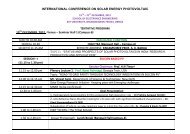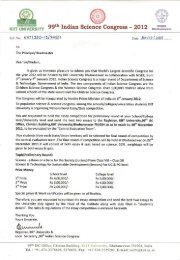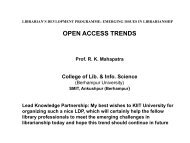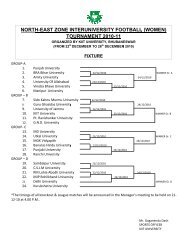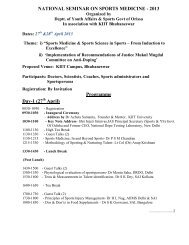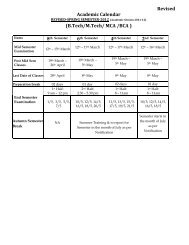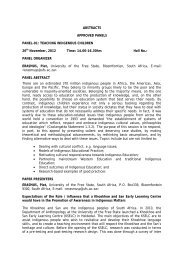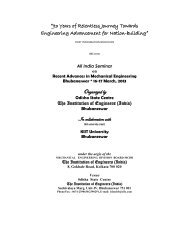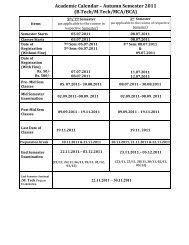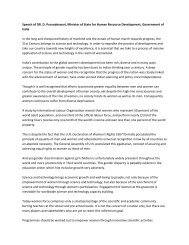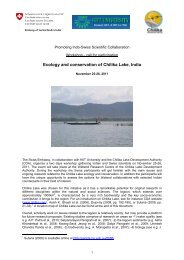The 1st KIIT University National Moot Court Competition, 2013
The 1st KIIT University National Moot Court Competition, 2013
The 1st KIIT University National Moot Court Competition, 2013
You also want an ePaper? Increase the reach of your titles
YUMPU automatically turns print PDFs into web optimized ePapers that Google loves.
<strong>The</strong> <strong>1st</strong> <strong>KIIT</strong> <strong>University</strong> <strong>National</strong> <strong>Moot</strong> <strong>Court</strong> <strong>Competition</strong>, <strong>2013</strong>Organising committeeChief PatronDr. A. SamantaFounder & Mentor, <strong>KIIT</strong> & KISSPatronsProf. (Dr.) N. L. MitraChancellor<strong>KIIT</strong> <strong>University</strong>Prof. (Dr.) P. P. MathurVice Chancellor<strong>KIIT</strong> <strong>University</strong><strong>National</strong> CoordinatorProf. (Dr.) N. K. ChakrabartiDirector, School of Law, <strong>KIIT</strong> <strong>University</strong>Faculty CoordinatorMr. Kumar KartikeyaAssistant Professor, School of Law, <strong>KIIT</strong> <strong>University</strong>Organizing CommitteeMr. Sudipta De SarkarProgramme Co-ordinator, School of Law, <strong>KIIT</strong> <strong>University</strong>Ms. Shreya ChatterjeeAssistant Professor, School of Law, <strong>KIIT</strong> <strong>University</strong>Ms. Kasturi BhagatAssistant Professor, School of Law, <strong>KIIT</strong> <strong>University</strong>Ms. Jinia KunduAssistant Professor, School of Law, <strong>KIIT</strong> <strong>University</strong>Student Co-CoordinatorsMr. Abinash BarikMr. Aishvary VikramSTATEMENT OF FACTS‘Samrajya’ is a country, located in the southern part of Asia. Its constitution and the laws are in parimateria, with the Indian Constitution and the laws prevailing in India. <strong>The</strong> Government of‘Samarajya’, as a part of its policy of liberalization/privatization, embarked upon the mechanism ofpublic-private partnership, in the projects involving development of infrastructure. In several suchprojects, the role of the Government is confined to being a mere facilitator, with the private partiesplaying the dominant role. However, this policy of the Government has come under severe criticismdue to allegations of corruption that have emerged in the award and execution of various projects. <strong>The</strong>critics of this policy also allege that Government was using the taxpayer’s money, for the benefit ofprivate interests. As a consequence, there was a general discontent and dissatisfaction with theGovernment, To stem the rising discontent and dissatisfaction against the Government, the Presidentof ‘Samarajya’ promulgated an Ordinance titled, Prevention of Corruption Ordinance, 2012 whichwas subsequently enacted by the Parliament of ‘Samarajya’, as Prevention of Corruption Act, 2012(hereinafter PCA). Under the Act, the Criminal Investigation Bureau (hereinafter C.I.B) wasdesignated as the chief investigating agency, with powers of investigation, arrest, search, seizure etc,in matters of corruption in various departments and organizations under the Government. To facilitatespeedy trial of cases relating to corruption, the Act also provided for setting up of special courts. <strong>The</strong>Act provided that any order of the said Special <strong>Court</strong> maybe challenged only by way of an appeal tothe Supreme <strong>Court</strong> of Samarajya. <strong>The</strong> fact, that C.I.B actually booked two ministers and severalofficers of the Government for corruption, deepened the discontent and dissatisfaction with theGovernment, instead of reducing it.<strong>The</strong>re were protests organized against the Government and its policies, in various parts of theCountry, which received widespread coverage in both electronic and print media. Incidents ofviolence were also reported from some other parts of the country as well, and the police had to resort touse of force, including firing on the protesters, at several places. <strong>The</strong> Government made repeatedappeals to the people to avoid acts of violence and keep the protests peaceful, but stray incidents ofviolence continued. Mr. Inquilaab Krantikari, a Professor of Law, in one of the well known LawUniversities, of the Country, who lead the protests in Jambudweep, the Capital of Samarajya, made anappeal to the people through newspapers, social networking sites, etc, to converge on the nationalcapital, on the First Sunday of January, <strong>2013</strong>, for a huge protest rally against the Government. On theday of the rally there was violence not only in the national capital, but also in other parts of the country.11




